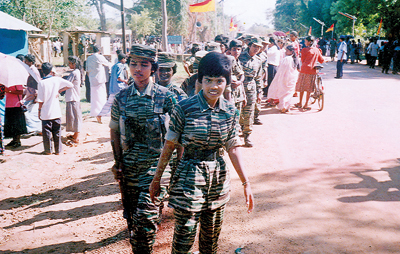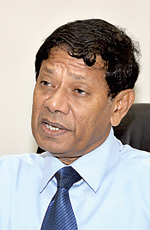Columns
Child soldiers – the tragedy and the transformation
Perhaps one of the most under- reported aspects of Sri Lanka’s 30 year war, is that of thousands of Tamil children who were robbed of their childhood to serve the military objectives of the LTTE. Except for a chance reference here or there, it is a story that by and large escaped the liberal media in the West, where one might have expected to find it.
The apparent bias in western media coverage of the war is evidence of the LTTE’s consummate success on the propaganda front. The group’s worst crimes such as the civilian massacres and the mass abductions of children to be used as cannon fodder, were largely obscured from sight.
To the average western citizen today, the LTTE and its many front organisations manifest themselves, ironically, as crusaders for human rights, baying for the blood of ‘war criminals.’ This reversal represents a PR heist, the likes of which the multi-billion dollar industry of Patton Boggs and Bell Pottinger cannot ever hope to match.

File Photo: Thousands of Tamil children were robbed of their childhood to serve the military objectives of the LTTE
Three years after the war’s end, a remarkable success has been recorded in the area of the rehabilitation of the LTTE’s ex-combatants. It has gone largely unacknowledged in the West. With its many humane aspects, it is a story that needs to be told. Quite apart from the fact that it would help counter the adverse propaganda about the Sri Lankan forces, so efficiently disseminated abroad, the lessons learnt from thisexercise need to be shared, on account of its importance as a model in the process of national reconciliation.
Five hundred and ninety four out of the 12,000 LTTE fighters among the 300,000 people who streamed out of the war zone in May 2009, were child soldiers aged 12-18. All of them have been through rehabilitation programmes and reunited with their families. Over 11,000 other ex-LTTEers have also been released after rehabilitation. A few hundred out of the 12,000 face legal process.
Some authoritative data on the programme designed by the Sri Lanka Army for the rehabilitation of ex-combatants was presented at the 2012 Defence Seminar this month. Both army and non-army personnel directly involved in the project made presentations on its different aspects. Some of the ‘beneficiaries’ of the exercise, as they are called (with due sensitivity to terminology), even presented song and dance items there, demonstrating their new found talents.
By all accounts this programme has been as modern and enlightened in conceptualisation and implementation, as one could hope to find anywhere in the world. According to Maj. Gen. Sudantha Ranasinghe, who was Commissioner General of Rehabilitation during the crucial stages, it is being used as a model in some other countries.
Clearly the attitude adopted towards the ex-combatants has been that they are “more sinned against than sinning.” The programme has adopted a holistic approach, with its components including Spiritual, Educational, Vocational and Livelihood rehabilitation, Social reintegration and Sports. The forms of therapy that were used included Psychological as well as Drama, Music and Art therapy. Those whose education had been disrupted, and who wished to pursue it, were given extra tuition in order to sit the O-Level and A-level exams.
It appears that civilian expertise has also been made use of. Through the involvement and good offices of actress Anoja Weerasinghe, some former child soldiers – now young adults – have started out on careers in film. Others have formed a cultural group, and still others, a western music band, trained by the Sri Lanka Army. The business community has chipped in to support a range of training courses in IT, apparel industry, masonry, carpentry, welding, electrical work etc. According to media reports, some rehabilitees have been selected for training to join the National Squads in various sports, and others have found employment in the Civil Defence Force.
Most importantly, those who designed the programme have given thought to the follow-through, after participants complete the course. Awareness programmes have been conducted to prepare communities to accept ex-combatants on their return. This, according to Maj. Gen. Ranasinghe, was done by educating government officials and religious and community leaders. Returnees are monitored for a period of six months.
The account of Sri Lanka’s rehabilitation program, as presented by its architects, suggests an impressive achievement within a relatively short time span. The question arises though, as to whether simply the sight of smiling faces, the hand-shakes and the dancing etc. is evidence of genuine change. Skeptics may ask whether those who came out of the war zone and who were identified as ex-combatants, were simply coerced into going through the motions required of them to complete the rehabilitation exercise. Was it possible this changed behaviour had nothing to do with the program itself? Maybe it was simply a result of the friendliness of the staff? Or was it just a matter of time?
This question was addressed by Prof. Arie Kruglanski of the University of Maryland’s Department of Psychology. He explored two research questions: 1) Did those who underwent rehabilitation de-radicalise, and 2) Why?
Presenting his findings at the Defence Seminar Kruglanski described how he used a ‘control group’ of ex-LTTE combatants who did not participate in the program, and compared them with those who went through it, in order to ascertain whether the program had brought about de-radicalisation. His ‘cautious’ conclusion was that it had. “We see a significant change in them. So this is remarkable” he said.
The 594 child soldiers who came out of the war zone and benefitted from the rehabilitation exercise, represent only a fraction of the total number of child soldiers. Many others formerly associated with armed groups, have not had access to the rehabilitation program. The UN report on Children in Armed Conflict 2011 in its chapter on Sri Lanka says that the whereabouts of 1,373 out of a total of 6,905 child soldiers of the LTTE remains unknown.
In December 2009 Sri Lankan government agencies supported by UNICEF set up a ‘Family Tracing and Reunification Unit’ for separated and unaccompanied children. Oddly this program appears to have no connection with the rehabilitation program run by the Army and the Bureau of Rehabilitation. It is only concerned with bringing the separated parties together. Seeing that the majority of the tracing applications relating to children were cases of LTTE recruitment, it seems unfortunate that this group did not have the benefit of the rehabilitation experience. Perhaps this is because of the compartmentalised way in which bureaucracies work.
The magnitude of the challenge of tracing and matching missing children with their families, and the underlying human tragedy, may be gauged by the comments of one of the key officials involved in this project. “It is a slow process,” he said in a telephone interview, relating how some children refuse to go to their families.
“They can’t recognise their parents. Some don’t even know their own names.” In some of these cases DNA testing was used to establish the relationship with the parents. Forty eight children have been returned to their families through the ‘Family Tracing and Reunification’ program.
Earlier this year Sri Lanka was removed from the UN’s blacklist relating to the abhorrent practice of child recruitment. No new cases of child recruitment by armed groups had been reported from Sri Lanka since October 2009.
comments powered by Disqus























